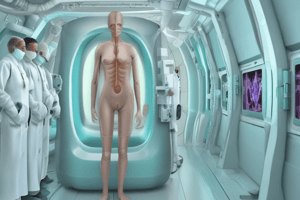Podcast
Questions and Answers
What is the primary use of the Model 44-2 sodium iodide gamma scintillator?
What is the primary use of the Model 44-2 sodium iodide gamma scintillator?
- Background radiation monitoring above 1.5 MeV
- High-level radiation detection
- Spectrum analysis without an analyzer
- Detecting low levels of gamma radiation (correct)
What is the size of the NaI crystal in the Model 44-2 detector?
What is the size of the NaI crystal in the Model 44-2 detector?
- 2.54 x 5.08 cm
- 2.54 x 2.54 cm (correct)
- 5.08 x 5.08 cm
- 1.27 x 1.27 cm
What is the recommended instrument input sensitivity for the Model 44-2 detector?
What is the recommended instrument input sensitivity for the Model 44-2 detector?
- 1 mV or higher
- Approximately 10 mV or higher (correct)
- 5 mV or higher
- 10 mV or higher
How does the Model 44-2 detector respond in the 100 keV range?
How does the Model 44-2 detector respond in the 100 keV range?
What is the thickness of the aluminum housing of the Model 44-2 detector?
What is the thickness of the aluminum housing of the Model 44-2 detector?
What is the typical sensitivity of the detector in counts per minute per micro-roentgen per hour?
What is the typical sensitivity of the detector in counts per minute per micro-roentgen per hour?
What is the effect of dead time on the linear range of the detector?
What is the effect of dead time on the linear range of the detector?
What is the purpose of the magnetically shielded photomultiplier tube?
What is the purpose of the magnetically shielded photomultiplier tube?
What is the efficiency of the detector for 125I?
What is the efficiency of the detector for 125I?
What is the operating temperature range of the detector?
What is the operating temperature range of the detector?
Flashcards are hidden until you start studying
Study Notes
Model 44-2 Sodium Iodide Gamma Scintillator
- Primarily used for detecting low levels of gamma radiation in the range of 20 keV–1.5 MeV
- Consists of a 2.54 x 2.54 cm (1 x 1 in.) NaI crystal coupled to a photomultiplier tube
- Housed in a 0.157 cm (0.062 in.) thick aluminum housing with a front entrance window of 2.3 mm (0.09 in.) thick aluminum
- Energy dependent, over-responding by a factor of 10 or greater in the 100 keV range and under-responding by a factor of 0.5 above 1 MeV when normalized to 137Cs
Operating Conditions and Applications
- Operates with any Ludlum instruments or equivalent instruments that provide 500–1200 volts
- Recommended instrument input sensitivity is approximately 10 mV or higher
- Common applications include:
- Background radiation monitoring
- Low-level radiation detection
- Spectrum analysis when used with a single or multi-channel analyzer
Specifications of the Instrument
- Compatible with general-purpose survey meters, ratemeters, and scalers
Sensitivity and Dead Time
- Typically 175 cpm per µR/hr for 137 Cs gamma
- Dead Time: approximately 10 µs
- Linear range limited to 5 mR/hr (50 µSv/h) without dead time correction
- Linear range extended to 50 mR/hr (500 µSv/h) with electronics equipped with dead time correction
Energy Response and Background
- Energy response is energy dependent
- Background measurement is 1800 cpm
Operating Conditions
- Operating Voltage: 500–1200 volts
- Dynode String Resistance: 100 megohm
Physical Properties
- Connector type: series ˝C˝ (others available)
- Scintillator size: 2.5 x 2.5 cm (1 x 1 in.) diameter and thickness
- Tube size: 2.9 cm (1.1 in.) diameter, magnetically shielded photomultiplier
Efficiency and Construction
- Efficiency (4 π): 7% for 125I, 10% for 57Co, 3% for 137Cs and 60Co
- Aluminum housing with beige powder-coat finish
Environmental Conditions
- Temperature Range: -15 to 50 °C (5 to 122 °F); optional certification for -40 to 65 °C (-40 to 150 °F)
- Size: 5.1 x 18.5 cm (2 x 7.3 in.) diameter and length
- Weight: 0.5 kg (1 lb)
Studying That Suits You
Use AI to generate personalized quizzes and flashcards to suit your learning preferences.




